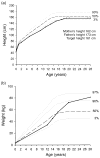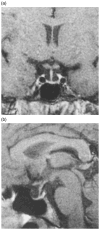A unique case of combined pituitary hormone deficiency caused by a PROP1 gene mutation (R120C) associated with normal height and absent puberty
- PMID: 12153609
- PMCID: PMC2932477
- DOI: 10.1046/j.1365-2265.2002.01550.x
A unique case of combined pituitary hormone deficiency caused by a PROP1 gene mutation (R120C) associated with normal height and absent puberty
Abstract
We report a 28-year-old-female who presented with primary amenorrhoea, absence of puberty, obesity and normal stature. The subject was clearly short as a child, with a height more than 2 SD below normal until the age of 15 years. The pubertal growth spurt failed to develop. She continued growing at a prepubertal rate until growth ceased at the age of 20 years, reaching her final adult height of 157 cm (SDS -0.86) without hormonal treatment. A combined pituitary hormone stimulation test of anterior pituitary function showed deficiencies of GH, LH and FSH, and low normal serum levels of TSH and PRL. Magnetic resonance imaging revealed a hypoplastic pituitary with markedly reduced pituitary height. In addition, a whole body dual energy X-ray absorptiometry scan showed high levels of body fat (54%). Combined pituitary hormone deficiencies with a hypoplastic pituitary suggested the diagnosis of a Prophet of Pit-1 (PROP1) gene mutation. Normal stature in this case, however, confounded this diagnosis. Sequencing of PROP1 revealed homozygosity for a single base-pair substitution (C to T), resulting in the replacement of an Arg by a Cys at codon 120 (R120C) in the third helix of the homeodomain of the Prop-1 protein. To our knowledge, this is the first report of a patient with a mutation in the PROP1 gene that attained normal height without hormonal treatment, indicating a new variability in the PROP1 phenotype, with important implications for the diagnosis of these patients. We suggest that this can be explained by (i) the presence of low levels of GH in the circulation during childhood and adolescence; (ii) the lack of circulating oestrogen delaying epiphyseal fusion, resulting in growth beyond the period of normal growth; and (iii) fusion of the epiphyseal plates, possibly as a result of circulating oestrogens originating from peripheral conversion of androgens by adipose tissue.
Figures



Comment in
-
GH deficiency might be associated with normal height in PROP1 deficiency.Clin Endocrinol (Oxf). 2002 Aug;57(2):157-8. doi: 10.1046/j.1365-2265.2002.01554.x. Clin Endocrinol (Oxf). 2002. PMID: 12153592 No abstract available.
Similar articles
-
Phenotypic variability in familial combined pituitary hormone deficiency caused by a PROP1 gene mutation resulting in the substitution of Arg-->Cys at codon 120 (R120C).J Clin Endocrinol Metab. 1998 Oct;83(10):3727-34. doi: 10.1210/jcem.83.10.5172. J Clin Endocrinol Metab. 1998. PMID: 9768691
-
[Genetic background of inherited multiple pituitary hormone deficiency. Mutations of PROP1 gene in Hungary].Orv Hetil. 2011 Feb 6;152(6):221-32. doi: 10.1556/OH.2011.29032. Orv Hetil. 2011. PMID: 21278027 Hungarian.
-
Long-term follow-up of combined pituitary hormone deficiency in two siblings with a Prophet of Pit-1 gene mutation.Gynecol Endocrinol. 2006 Dec;22(12):704-9. doi: 10.1080/09513590601030290. Gynecol Endocrinol. 2006. PMID: 17162714
-
PROP1-Related Combined Pituitary Hormone Deficiency.2000 Dec 7 [updated 2022 Feb 24]. In: Adam MP, Feldman J, Mirzaa GM, Pagon RA, Wallace SE, Amemiya A, editors. GeneReviews® [Internet]. Seattle (WA): University of Washington, Seattle; 1993–2025. 2000 Dec 7 [updated 2022 Feb 24]. In: Adam MP, Feldman J, Mirzaa GM, Pagon RA, Wallace SE, Amemiya A, editors. GeneReviews® [Internet]. Seattle (WA): University of Washington, Seattle; 1993–2025. PMID: 20301521 Free Books & Documents. Review.
-
Combined pituitary hormone deficiency caused by a novel mutation of a highly conserved residue (F88S) in the homeodomain of PROP-1.J Clin Endocrinol Metab. 2000 Aug;85(8):2779-85. doi: 10.1210/jcem.85.8.6744. J Clin Endocrinol Metab. 2000. PMID: 10946881 Review.
Cited by
-
Isolated central hypothyroidism in young siblings as a manifestation of PROP1 deficiency: clinical impact of whole exome sequencing.Horm Res Paediatr. 2013;79(6):379-86. doi: 10.1159/000350013. Epub 2013 May 3. Horm Res Paediatr. 2013. PMID: 23652424 Free PMC article.
-
The natural history of the R120C PROP1 mutation reveals a wide phenotypic variability in two untreated adult brothers with combined pituitary hormone deficiency.Endocrine. 2006 Dec;30(3):365-9. doi: 10.1007/s12020-006-0015-2. Endocrine. 2006. PMID: 17526949
-
Growth without growth hormone in combined pituitary hormone deficiency caused by pituitary stalk interruption syndrome.Ann Pediatr Endocrinol Metab. 2017 Mar;22(1):55-59. doi: 10.6065/apem.2017.22.1.55. Epub 2017 Mar 31. Ann Pediatr Endocrinol Metab. 2017. PMID: 28443260 Free PMC article.
-
Magnetic resonance imaging of the hypothalamus-pituitary unit in childrensuspected of hypopituitarism: who, how and when toinvestigate.J Endocrinol Invest. 2004 May;27(5):496-509. doi: 10.1007/BF03345298. J Endocrinol Invest. 2004. PMID: 15279086 Review.
-
Case seminar: a young female with acute hyponatremia and a sellar mass.Endocrine. 2011 Dec;40(3):325-31. doi: 10.1007/s12020-011-9516-8. Epub 2011 Aug 24. Endocrine. 2011. PMID: 21863341
References
-
- Baars J, Van den Broeck J, le Cessie S, Massa G, Wit JM. Body mass index in growth hormone deficient children before and during growth hormone treatment. Hormone Research. 1998;49:39–45. - PubMed
-
- Blake GM, Wahner HW, Forgelman I. The Evaluation of Osteoporosis: Dual Energy X-Ray Absormetry and Ultrasound in Clinical Practice. 2. Martin Dunitz Ltd; London: 1999.
-
- Blethen SL, Compton P, Lippe BM, Rosenfeld RG, August GP, Johanson A. Factors predicting the response to growth hormone (GH) therapy in prepubertal children with GH deficiency. Journal of Clinical Endocrinology and Metabolism. 1993;76:574–579. - PubMed
-
- Bulun SE, Zeitoun K, Sasano H, Simpson ER. Aromatase in aging women. Seminars in Reproductive Endocrinology. 1999;17:349–358. - PubMed
Publication types
MeSH terms
Substances
Grants and funding
LinkOut - more resources
Full Text Sources

